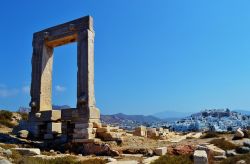
The Museum of Prehistoric Thera
14-03-2017 10:40
The Museum of Prehistoric Thera houses finds from the excavations at Akrotiri, conducted under the auspices of the Archaeological Society at Athens, the earlier excavations at Potamos, made by members of the German Archaeological Institute at Athens, and rescue excavations at various other sites on the island, carried out by the XXI Ephorate of Antiquities for the Cyclades and Samos, as well as objects discovered fortuitously or handed over.
The exhibition is structured in four units, referring to the history of research at Thera, the geology of Thera, the island's history from the Late Neolithic to the Late Cycladic I period, and the heyday of the city at Akrotriri. In the last unit in particular, various aspects are presented, such as the plan and architecture of the city and its organiztion as an urban centre, the emergent bureaucratic system, the development of the monumental art of wall paintng, the rich and diverse potery repertoire, the reciprocal infuences between vase painting and wall painting, the elegant jewellery, and the city's and the island's complex network of contacts with the outside world.
The exhibits include fossils of plants that flourished before the human habitation of Thera and archaeological objects. Among the earliest pieces are Neolithic pottery, Early Cycladic marble figurines, Early Cycladic pottery -including interesting pieces of the transitional phase from the EC II to ECiii period (Kastri group) from the Christiana islets and Akrotiri (3000-2000 BC)- , Middle Cycladic pottery with a series of impressive bird jugs -many of them decorated with swallows- from Ftellos, Aghios Ioannis Elemon, Megalochori and Akrotiri and Early Cycladic metal artefacts from the last two sites.
Noteworthy among the numerous exhibits from the period when the city at Akrtori was at its zenith (17th c. BC) are the plaster casts of furniture, the household equipmnet, the bronze vessels, tools and weapons, the objects that bear withness to the practice of metalworking, the sealings, seals and Linear A tablets. Impressive too are the magnificent wall-painting ensembles (wall paintings of Ladies and Papyri, wall painting of the Blue Monkeys) and fragments of others (the African, Ardorant Monkeys, Bird, floral motifs). Last, there are numerous and luxurious clay vases including the remarkable pithos with the bull and the dolphins, vases of stone and of clay imported from differnet parts of the Aegean and the Eastern Mediterranean, and the gold ibex figurine, a remarkable find.
the exhibition endeavours to sketch the course of Thera in prehistoric times, through selected finds from the thousands in the storerooms. This was a dynamic and creative course which established the city at Acrotiri as one f the most important Aegean centres during the 18th and 17th centuries BC.














